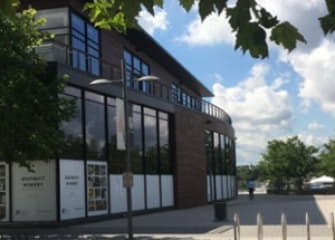
District Winery is the city’s first urban winery, housing every part of the wine making process from crushing grapes to bottling the product. The 17,000-square-foot space designed by HapstakDemetriou+ opened recently at the Southeast waterfront at 385 Water St. SE in Washington DC.
The winery includes a private event space, an outdoor terrace that looks onto the Anacostia River, a restaurant and a bridal suite with barrels and bottling equipment visible throughout the modern glass paneled space. A collection of portraits of each president – shown in vibrant colors and styles along the back wall of the restaurant – adds a fun and welcoming ambiance to the elegant space.
Stainless steel tanks inside District Winery hold crushed grapes before they are fermented and turned into wine.
The D.C. location provides access to people who want a wine tasting experience without leaving the city. The next closest winery is in Silver Spring, Md. District Winery will be the first space to craft wine in D.C.
District Winery currently sources grapes from a variety of boutique vineyards, mostly in California. Head winemaker Conor McCormack said the space is able to accommodate a wide range of wines, from merlots to rosés, by keeping them in different temperature-controlled rooms for the different stages of fermentation.
Ana, the restaurant inside District Winery, has a modern interior with presidential portraits that offer pops of color.
The grapes are kept in small boxes to prevent premature fermentation and are transported to the city in refrigerated trucks to keep them at the exact right temperature. McCormack said the grapes can travel for up to seven days this way while maintaining freshness. Immediately after the grapes are unloaded off the truck, they’re de-stemmed and the fermentation process begins.
The main production room of the winery houses bins of pinot noir grapes from Sonoma County that are fermenting and warming up to the right temperature. Yeast is added to the grapes before to absorb the sugar they developed on the vine and convert it to alcohol.
Once no more sugar is left, a press will separate solid from liquids and the wine is poured into barrels where it stays for about 10 months. After another six months in bottles, the wine will be ready to serve – in May 2019.


































